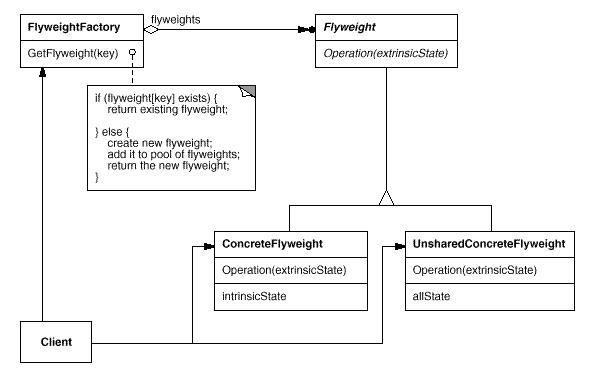常见设计模式的解析和实现(C++)之十三-FlyWeight模式
2007-06-25 10:01
806 查看
作用:
运用共享技术有效地支持大量细粒度的对象。
UML结构图:

解析:
Flyweight 模式在大量使用一些可以被共享的对象的时候经常使用.比如,在QQ聊天的时候很多时候你懒得回复又不得不回复的时候,一般会用一些客套的话语敷衍别人,如 "呵呵","好的"等等之类的,这些简单的答复其实每个人都是提前定义好的,在使用的时候才调用出来.Flyweight就是基于解决这种问题的思路而产 生的,当需要一个可以在其它地方共享使用的对象的时候,先去查询是否已经存在了同样的对象,如果没有就生成之有的话就直接使用.因此,Flyweight 模式和Factory模式也经常混用.
实现:
需要说明的是下面的实现仅仅实现了对可共享对象的使用,非可共享对象的使用没有列 出,因为这个不是Flyweight模式的重点.这里的实现要点是采用一个list链表来保存这些可以被共享的对象,需要使用的时候就到链表中查询是不是 已经存在了,如果不存在就初始化一个,然后返回这个对象的指针.
1)Flyweight.h

/********************************************************************

created: 2006/07/26

filename: FlyWeight.h

author: 李创

http://www.cppblog.com/converse/


purpose: FlyWeight模式的演示代码

*********************************************************************/


#ifndef FLYWEIGHT_H

#define FLYWEIGHT_H


#include <string>

#include <list>


typedef std::string STATE;


class Flyweight


{

public:


virtual ~Flyweight()

{}


STATE GetIntrinsicState();

virtual void Operation(STATE& ExtrinsicState) = 0;


protected:

Flyweight(const STATE& state)

:m_State(state)



{

}


private:

STATE m_State;

};


class FlyweightFactory


{

public:


FlyweightFactory()

{}

~FlyweightFactory();


Flyweight* GetFlyweight(const STATE& key);


private:

std::list<Flyweight*> m_listFlyweight;

};


class ConcreateFlyweight

: public Flyweight


{

public:

ConcreateFlyweight(const STATE& state)

: Flyweight(state)



{

}


virtual ~ConcreateFlyweight()

{}


virtual void Operation(STATE& ExtrinsicState);

};


#endif


/**/



2)Flyweight.cpp

/********************************************************************

created: 2006/07/26

filename: FlyWeight.cpp

author: 李创

http://www.cppblog.com/converse/


purpose: FlyWeight模式的演示代码

*********************************************************************/


#include "FlyWeight.h"

#include <iostream>


inline STATE Flyweight::GetIntrinsicState()


{

return m_State;

}


FlyweightFactory::~FlyweightFactory()


{

std::list<Flyweight*>::iterator iter1, iter2, temp;


for (iter1 = m_listFlyweight.begin(), iter2 = m_listFlyweight.end();

iter1 != iter2;

)



{

temp = iter1;

++iter1;

delete (*temp);

}


m_listFlyweight.clear();

}


Flyweight* FlyweightFactory::GetFlyweight(const STATE& key)


{

std::list<Flyweight*>::iterator iter1, iter2;


for (iter1 = m_listFlyweight.begin(), iter2 = m_listFlyweight.end();

iter1 != iter2;

++iter1)



{

if ((*iter1)->GetIntrinsicState() == key)



{

std::cout << "The Flyweight:" << key << " already exits"<< std::endl;

return (*iter1);

}

}


std::cout << "Creating a new Flyweight:" << key << std::endl;

Flyweight* flyweight = new ConcreateFlyweight(key);

m_listFlyweight.push_back(flyweight);

}


void ConcreateFlyweight::Operation(STATE& ExtrinsicState)


{


}


/**/




3)Main.cpp

/********************************************************************

created: 2006/07/26

filename: Main.cpp

author: 李创

http://www.cppblog.com/converse/


purpose: FlyWeight模式的测试代码

*********************************************************************/


#include "FlyWeight.h"


int main()


{

FlyweightFactory flyweightfactory;

flyweightfactory.GetFlyweight("hello");

flyweightfactory.GetFlyweight("world");

flyweightfactory.GetFlyweight("hello");


system("pause");

return 0;

}

/**/

运用共享技术有效地支持大量细粒度的对象。
UML结构图:

解析:
Flyweight 模式在大量使用一些可以被共享的对象的时候经常使用.比如,在QQ聊天的时候很多时候你懒得回复又不得不回复的时候,一般会用一些客套的话语敷衍别人,如 "呵呵","好的"等等之类的,这些简单的答复其实每个人都是提前定义好的,在使用的时候才调用出来.Flyweight就是基于解决这种问题的思路而产 生的,当需要一个可以在其它地方共享使用的对象的时候,先去查询是否已经存在了同样的对象,如果没有就生成之有的话就直接使用.因此,Flyweight 模式和Factory模式也经常混用.
实现:
需要说明的是下面的实现仅仅实现了对可共享对象的使用,非可共享对象的使用没有列 出,因为这个不是Flyweight模式的重点.这里的实现要点是采用一个list链表来保存这些可以被共享的对象,需要使用的时候就到链表中查询是不是 已经存在了,如果不存在就初始化一个,然后返回这个对象的指针.
1)Flyweight.h

/********************************************************************

created: 2006/07/26

filename: FlyWeight.h

author: 李创

http://www.cppblog.com/converse/


purpose: FlyWeight模式的演示代码

*********************************************************************/


#ifndef FLYWEIGHT_H

#define FLYWEIGHT_H


#include <string>

#include <list>


typedef std::string STATE;


class Flyweight


{

public:


virtual ~Flyweight()

{}


STATE GetIntrinsicState();

virtual void Operation(STATE& ExtrinsicState) = 0;


protected:

Flyweight(const STATE& state)

:m_State(state)



{

}


private:

STATE m_State;

};


class FlyweightFactory


{

public:


FlyweightFactory()

{}

~FlyweightFactory();


Flyweight* GetFlyweight(const STATE& key);


private:

std::list<Flyweight*> m_listFlyweight;

};


class ConcreateFlyweight

: public Flyweight


{

public:

ConcreateFlyweight(const STATE& state)

: Flyweight(state)



{

}


virtual ~ConcreateFlyweight()

{}


virtual void Operation(STATE& ExtrinsicState);

};


#endif


/**/



2)Flyweight.cpp

/********************************************************************

created: 2006/07/26

filename: FlyWeight.cpp

author: 李创

http://www.cppblog.com/converse/


purpose: FlyWeight模式的演示代码

*********************************************************************/


#include "FlyWeight.h"

#include <iostream>


inline STATE Flyweight::GetIntrinsicState()


{

return m_State;

}


FlyweightFactory::~FlyweightFactory()


{

std::list<Flyweight*>::iterator iter1, iter2, temp;


for (iter1 = m_listFlyweight.begin(), iter2 = m_listFlyweight.end();

iter1 != iter2;

)



{

temp = iter1;

++iter1;

delete (*temp);

}


m_listFlyweight.clear();

}


Flyweight* FlyweightFactory::GetFlyweight(const STATE& key)


{

std::list<Flyweight*>::iterator iter1, iter2;


for (iter1 = m_listFlyweight.begin(), iter2 = m_listFlyweight.end();

iter1 != iter2;

++iter1)



{

if ((*iter1)->GetIntrinsicState() == key)



{

std::cout << "The Flyweight:" << key << " already exits"<< std::endl;

return (*iter1);

}

}


std::cout << "Creating a new Flyweight:" << key << std::endl;

Flyweight* flyweight = new ConcreateFlyweight(key);

m_listFlyweight.push_back(flyweight);

}


void ConcreateFlyweight::Operation(STATE& ExtrinsicState)


{


}


/**/




3)Main.cpp

/********************************************************************

created: 2006/07/26

filename: Main.cpp

author: 李创

http://www.cppblog.com/converse/


purpose: FlyWeight模式的测试代码

*********************************************************************/


#include "FlyWeight.h"


int main()


{

FlyweightFactory flyweightfactory;

flyweightfactory.GetFlyweight("hello");

flyweightfactory.GetFlyweight("world");

flyweightfactory.GetFlyweight("hello");


system("pause");

return 0;

}

/**/

相关文章推荐
- 常见设计模式的解析和实现(C++)之十三-FlyWeight模式
- 常见设计模式解析和实现(C++)FlyWeight模式
- 常见设计模式解析和实现(C++)FlyWeight模式
- 设计模式的解析和实现(C++)之十三-FlyWeight模式
- 常见设计模式解析和实现(C++)FlyWeight模式
- 常见设计模式解析和实现(C++)Prototype模式(原型模式)
- 常见设计模式的解析和实现(C++)之八-Composite模式
- 常见设计模式的解析和实现(C++)之十六-Strategy模式
- 常见设计模式的解析和实现(C++)之二十-Visitor模式
- 常见设计模式的解析和实现(C++)---Adapt模式
- 常见设计模式的解析和实现(C++)之二-Abstract Factory模式
- 常见设计模式的解析和实现(C++)之六-Adapt模式
- 常见设计模式的解析和实现(C++)之十六-Strategy模式
- 常见设计模式的解析和实现(C++)之十-Proxy模式
- 常见设计模式的解析和实现(C++)之五-Singleton模式
- 常见设计模式的解析和实现(C++)之三-Builder模式
- 常见设计模式的解析和实现(C++)之十-Proxy模式
- 常见设计模式解析和实现(C++)Prototype模式(原型模式)
- 常见设计模式的解析和实现(C++)之九—Decorator模式
- 常见设计模式的解析和实现(C++)之二十一-完结篇
